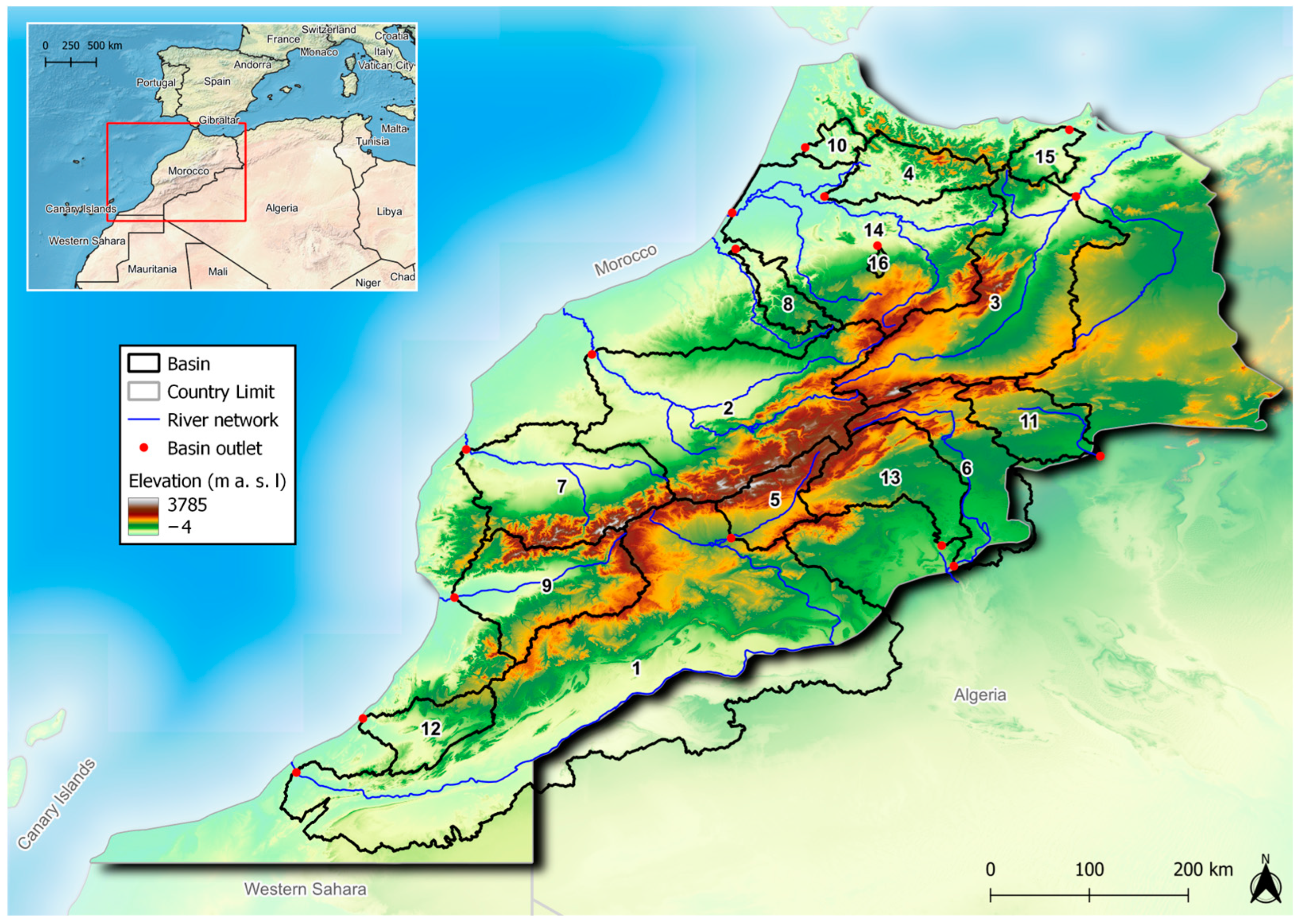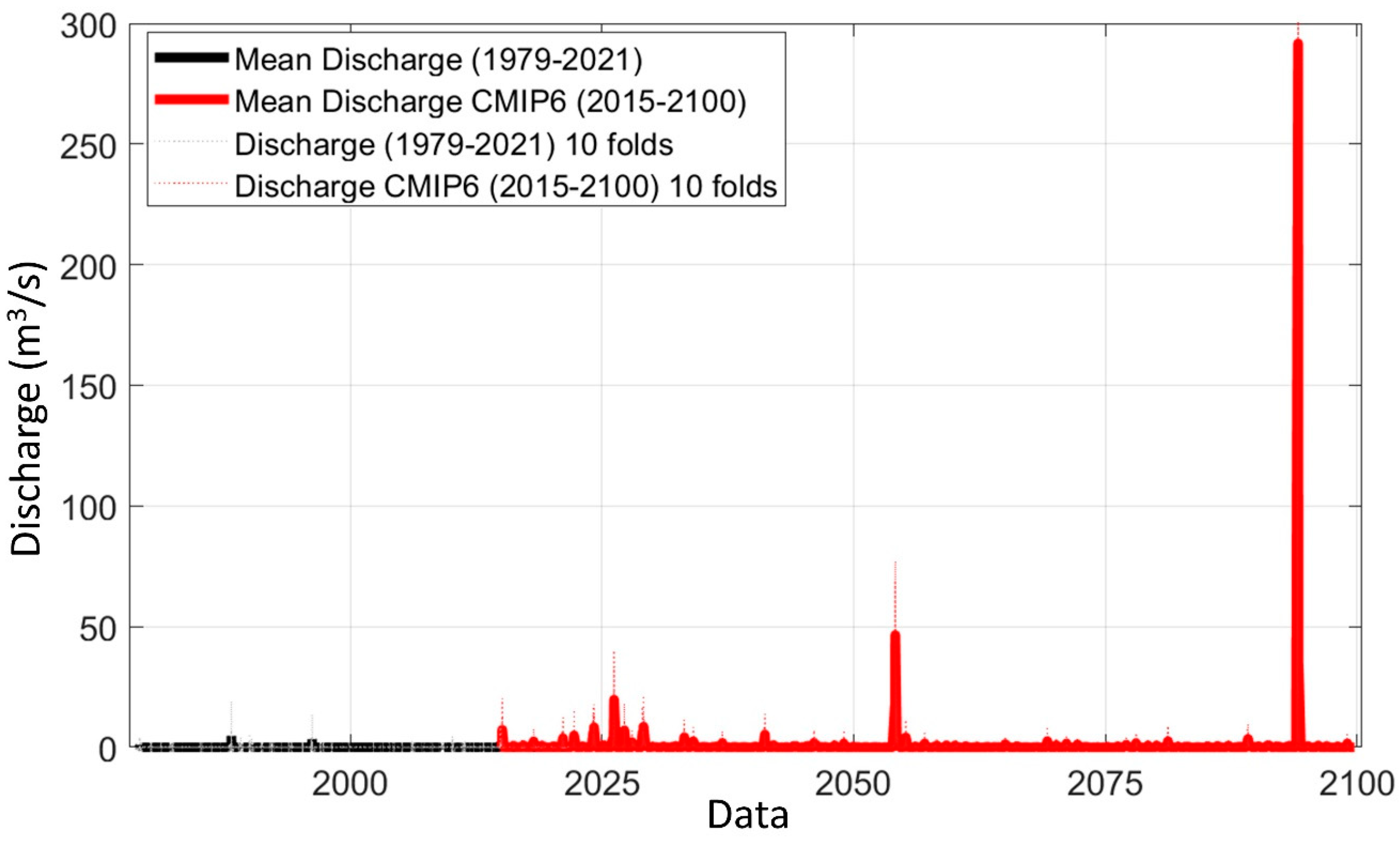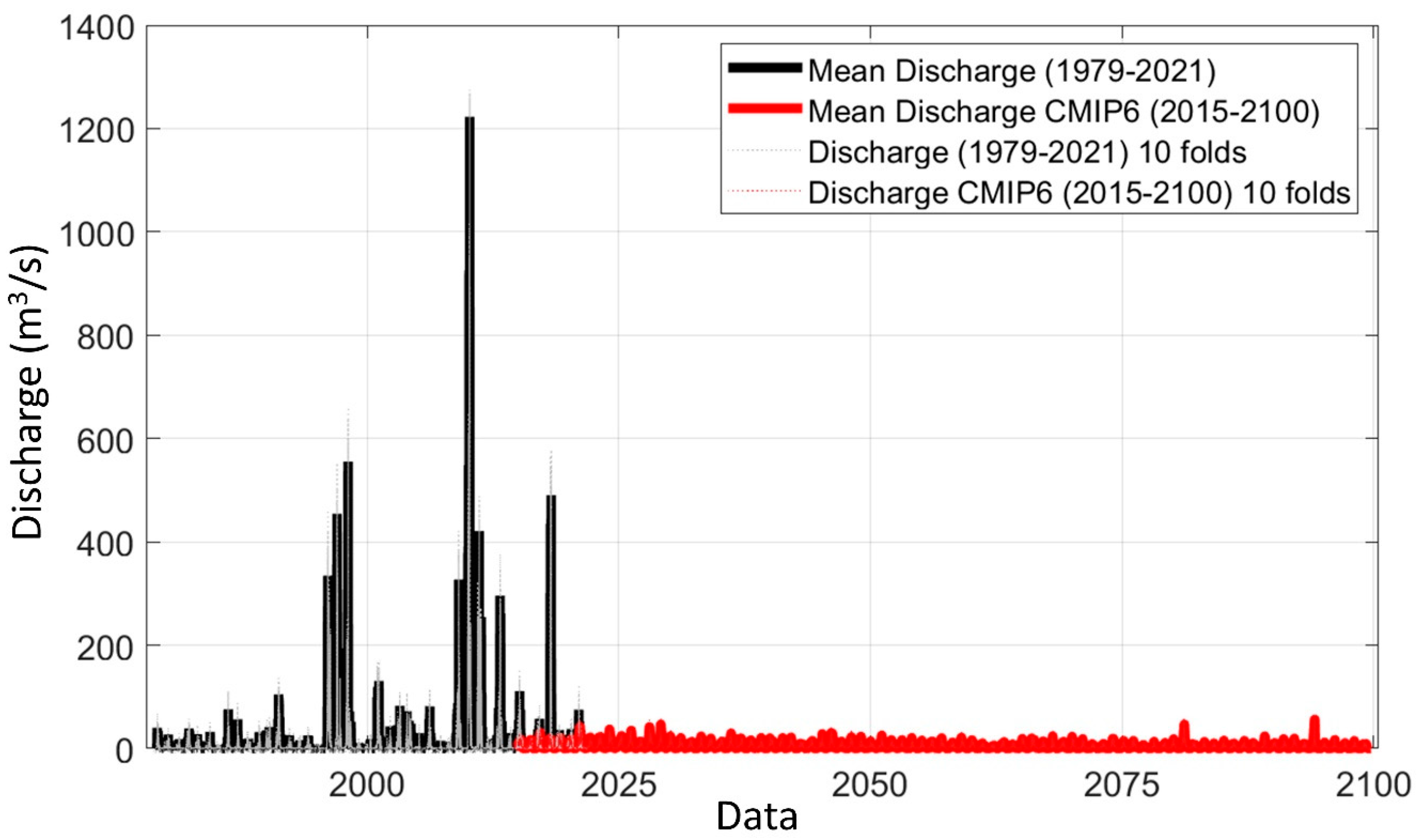Simulating Changes in Hydrological Extremes—Future Scenarios for Morocco
Abstract
:1. Introduction
- (1)
- How will the frequency and magnitude of hydrological extremes be impacted in Morocco by 2100 under climate change?
- (2)
- Which basin areas in Morocco will experience changes in hydrological extremes under climate change, and in which direction?
2. Materials and Methods
2.1. Historical Datasets
2.2. Climate Change Datasets
2.3. Hydrological Model Parameterization
3. Methodology
4. Results
5. Discussion
6. Conclusions
Author Contributions
Funding
Data Availability Statement
Acknowledgments
Conflicts of Interest
References
- IPCC. Summary for Policymakers. In Global Warming of 1.5 °C. An IPCC Special Report on the Impacts of Global Warming of 1.5 °C above Pre-Industrial Levels and Related Global Greenhouse Gas Emission Pathways, in the Context of Strengthening the Global Response to the Threat of Climate Change, Sustainable Development, and Efforts to Eradicate Poverty; Masson-Delmotte, V., Zhai, P., Pörtner, H.-O., Roberts, D., Skea, J., Shukla, P.R., Pirani, A., Moufouma-Okia, W., Péan, C., Pidcock, R., et al., Eds.; Cambridge University Press: Cambridge, UK, 2018; pp. 3–24. [Google Scholar] [CrossRef]
- Panagoulia, D.; Dimou, G. Sensitivity of flood events to global climate change. J. Hydrol. 1997, 191, 208–222. [Google Scholar] [CrossRef]
- Wehner, M.; Sampson, C. Attributable human-induced changes in the magnitude of flooding in the Houston, Texas region during Hurricane Harvey. Clim. Change 2021, 166, 20. [Google Scholar] [CrossRef]
- Wayne Higgins, R.; Douglas, A.; Hahmann, A.; Berbery, E.H.; Gutzler, D.; Shuttleworth, J.; Stensrud, D.; Amador, J.; Carbone, R.; Cortez, M.; et al. Progress in pan American CLIVAR research: The North American Monsoon system. Atmosfera 2003, 16, 29–65. [Google Scholar]
- Born, K.; Fink, A.; Knippertz, P. I-5.2: Meteorological processes influencing the weather and climate of Morocco. In Impacts of Global Change on the Hydrological Cycle in West and Northwest Africa; Springer: Berlin/Heidelberg, Germany, 2010; pp. 150–163. [Google Scholar]
- Born, K.; Fink, A.H.; Paeth, H. Dry and wet periods in the northwestern Maghreb for present day and future climate conditions. Meteorol. Z. 2008, 17, 533–551. [Google Scholar] [CrossRef]
- Driouech, F.; Déqué, M.; Sánchez-Gómez, E. Weather regimes—Moroccan precipitation link in a regional climate change simulation. Glob. Planet. Chang. 2010, 72, 1–10. [Google Scholar] [CrossRef]
- Benassi, M. Drought and climate change in Morocco. Analysis of precipitation field and water supply. In Drought Management: Scientific and Technological Innovations; López-Francos, A., Ed.; CIHEAM: Zaragoza, Spain, 2008; pp. 83–86. [Google Scholar]
- Driouech, F.; Déqué, M.; Mokssit, A. Numerical simulation of the probability distribution function of precipitation over Morocco. Clim. Dyn. 2008, 32, 1055–1063. [Google Scholar] [CrossRef]
- Saidi, A.D.; Szönyi, M. Risk Nexus. In Morocco Floods of 2014: What We Can Learn from Guelmim and Sidi Ifni; Zurich Insurance Group and Targa-AIDE: Zurich, Switzerland, 2015. [Google Scholar]
- Van Dijck, S.J.E.; Laouina, S.; Carvalho, A.V.; Loos, S.; Schipper, A.M.; Van der Kwast, H.; Nafaa, R.; Antari, M.; Rocha, A.; Borrego, C.; et al. Desertification in Northern Morocco due to effects of climate change on groundwater recharge. In Desertification in the Mediterranean Region. A Security Issue; Kepner, W.G., Rubio, J.L., Mouat, D.A., Pedrazzini, F., Eds.; Kluwer Academic Publishers: Dordrecht, The Netherlands, 2006; pp. 549–577. [Google Scholar]
- Tramblay, Y.; Badi, W.; Driouech, F.; El Adlouni, S.; Neppel, L.; Servat, E. Climate change impacts on extreme precipitation in Morocco. Glob. Planet. Chang. 2012, 82–83, 104–114. [Google Scholar] [CrossRef]
- Driouech, F.; Ben Rached, S.; Hairech, T.E. Climate Variability and Change in North African Countries. In Climate Change and Food Security in West Asia and North Africa; Springer: Dordrecht, The Netherlands, 2013; pp. 161–172. [Google Scholar]
- Hapuarachchi, H.A.P.; Wang, Q.J.; Pagano, T.C. A review of advances in flash flood forecasting. Hydrol. Process. 2011, 25, 2771–2784. [Google Scholar] [CrossRef]
- World Bank. Building Morocco’s Resilience: Inputs from an Integrated Risk Management Strategy; World Bank: Washington, DC, USA, 2013. [Google Scholar]
- Ouazarr, D. Integrated Flood Management: Data /Big Data, Models, (Un)certainty and Knowledge; IFM: Rabat, Morocco, 2015. [Google Scholar]
- Karmaoui, A.; Balica, S.; Messouli, M. Analysis of applicability of flood vulnerability index in Pre-Saharan region, a pilot study to assess flood in Southern Morocco. Nat. Hazards Earth Syst. Sci. Discuss. 2016, 1–24. [Google Scholar] [CrossRef] [Green Version]
- Snoussi, M.; Ouchani, T.; Niazi, S. Vulnerability assessment of the impact of sea-level rise and flooding on the Moroccan coast: The case of the Mediterranean eastern zone. Estuar. Coast. Shelf Sci. 2008, 77, 206–213. [Google Scholar] [CrossRef]
- Azidane, H.; Benmohammadi, A.; Hakkou, M.; Magrane, B.; Haddout, S. A Geospatial approach for assessing the impacts of sea-level rise and flooding on the Kenitra coast (Morocco). J. Mater. Environ. Sci. 2018, 9, 1480–1488. [Google Scholar] [CrossRef]
- OECD. OECD Review of Risk Management Policies Morocco; OECD Publishing: Paris, France, 2017. [Google Scholar]
- Roman, A.; Hssaine, A.A. Causes and consequences of the November 2014 torrential rains in the center & south of Morocco. Int. J. Environ. 2016, 5, 11–30. [Google Scholar] [CrossRef] [Green Version]
- OECD. Guide Pratique. In Connaitre et Evaluer les Risques de Catastrophes Naturelles au Maroc; OECD Publishing: Paris, France, 2018. [Google Scholar]
- Fadil, A.; Rhinane, H.; Kaoukaya, A.; Kharchaf, Y.; Alami, B.O. Hydrologic Modeling of BouregregWatershed (Morocco) Using GIS and SWAT Model. J. Geogr. Inf. Syst. 2011, 3, 279–289. [Google Scholar]
- Khalid, C. Hydrological modeling of the Mikkés watershed (Morocco) using ARCSWAT model. Sustain. Water Resour. Manag. 2018, 4, 105–115. [Google Scholar] [CrossRef]
- Boufala, M.; El Hmaidi, A.; Chadli, K.; Essahlaoui, A.; El Ouali, A.; Taia, S. Hydrological modeling of water and soil resources in the basin upstream of the Allal El Fassi dam (Upper Sebou watershed, Morocco). Model. Earth Syst. Environ. 2019, 5, 1163–1177. [Google Scholar] [CrossRef]
- Azouagh, A.; El Bardai, R.; Hilal, I.; el Messari, J.S. Integration of GIS and HEC-RAS in Floods Modeling of Martil River (Northern Morocco). Eur. Sci. J. ESJ 2018, 14, 130. [Google Scholar] [CrossRef]
- Adjinacou, A.M. Flood Modeling and Floodplain Mapping Based on Geographical Information System (GIS) and HEC-RAS in Oued Fez Watershed (Morocco); Pan African University Institute of Water and Energy Sciences (including Climate Change): Tlemcen, Algeria, 2016. [Google Scholar]
- Echogdali, F.Z.; Boutaleb, S.; Jauregui, J.; Elmouden, A. Cartography of Flooding Hazard in Semi-Arid Climate: The Case of Tata Valley (South-East of Morocco). J. Geogr. Nat. Disasters 2018, 8, 1–11. [Google Scholar] [CrossRef]
- Bourak, A.; Midaoui, A.; Lahrach, A.; Elarrim, A.; Chaouni, A.-A. Modélisation hydraulique du système Sebou-Fouarat, ville de Kenitra, Maroc—Cas des inondations de 2010. Eur. Sci. J. ESJ 2017, 13, 369–383. [Google Scholar] [CrossRef] [Green Version]
- Fatma, C.S.E.K. Délimitation des Zones Inondables par L’utilisation Combiné du Logiciel HEC-RAS et HEC GEORAS cas du Centre « Ain Jemaa »; Université Sidi Mohamed Ben Abdellah Fès: Fes, Morocco, 2013. [Google Scholar]
- Tabyaoui, H.; El Hammichi, F.; Er-Rguiouag, M.A.; Lahrach, A. Hydraulic Modelling Using HEC-RAS and GIS, Application to Oued Inaouen. In Taza, Northern Morocco; Sidi Mohamed Ben Abdellah University: Taza, Morocco; Fes, Morocco, 2011. [Google Scholar]
- El-Hamdouny, M.; Abdelbaset, M.; El Hassani, F.; Gmira, S.; Lahrach, A.; Chaouni, A.A. Delimitation of flood areas based on hydrological calculation and hydraulic modeling: Case of Malal village in the province of Taza (Morocco). Am. J. Innov. Res. Appl. Sci. 2016, 6, 11–19. [Google Scholar]
- Werren, G.; Lasri, M. Cartographie du danger d’inondation. In Guide Pratique Pour L’application de la Méthode Suisse au Maroc; Institut de Géographie et Durabilité de l’Université de Lausanne (IGD): Lausanne, Switzerland; Laboratoire d’analyses géo-environnementales et aménagement de l’Université Sidi Mohamed Ben Abdellah Fès (LAGEA): Fes, Morocco, 2014. [Google Scholar]
- Werren, G.; Reynard, E.; Lane, S.N.; Balin, D. Flood hazard assessment and mapping in semi-arid piedmont areas: A case study in Beni Mellal, Morocco. Nat. Hazards 2015, 81, 481–511. [Google Scholar] [CrossRef] [Green Version]
- Fels, A.E.A.E.; Alaa, N.; Bachnou, A.; Rachidi, S. Flood frequency analysis and generation of flood hazard indicator maps in a semi-arid environment, case of Ourika watershed (western High Atlas, Morocco). J. Afr. Earth Sci. 2018, 141, 94–106. [Google Scholar] [CrossRef]
- Zellou, B.; Rahali, H. Assessment of reduced-complexity landscape evolution model suitability to adequately simulate flood events in complex flow conditions. Nat. Hazards 2016, 86, 1–29. [Google Scholar] [CrossRef]
- Chabaane, M.S.; Abouali, N.; Boumeaza, T.; Zahouily, M.; Yazidi, A.O. Three-dimensional simulation of a centennial flood of Mohammedia city in the the river of El Maleh—Morocco. J. Mater. Environ. Sci. 2019, 10, 305–315. [Google Scholar]
- Majone, B.; Avesani, D.; Zulian, P.; Fiori, A.; Bellin, A. Analysis of high streamflow extremes in climate change studies: How do we calibrate hydrological models? Hydrol. Earth Syst. Sci. 2022, 26, 3863–3883. [Google Scholar] [CrossRef]
- Thrasher, B.; Wang, W.; Michaelis, A.; Melton, F.; Lee, T.; Nemani, R. NASA Global Daily Downscaled Projections, CMIP6. Sci. Data 2022, 9, 262. [Google Scholar] [CrossRef]
- O′Neill, B.C.; Tebaldi, C.; van Vuuren, D.P.; Eyring, V.; Friedlingstein, P.; Hurtt, G.; Knutti, R.; Kriegler, E.; Lamarque, J.-F.; Lowe, J.; et al. The Scenario Model Intercomparison Project (ScenarioMIP) for CMIP6. Geosci. Model Dev. 2016, 9, 3461–3482. [Google Scholar] [CrossRef] [Green Version]
- Meinshausen, M.; Nicholls, Z.R.J.; Lewis, J.; Gidden, M.J.; Vogel, E.; Freund, M.; Beyerle, U.; Gessner, C.; Nauels, A.; Bauer, N.; et al. The shared socio-economic pathway (SSP) greenhouse gas concentrations and their extensions to 2500. Geosci. Model Dev. 2020, 13, 3571–3605. [Google Scholar] [CrossRef]
- Hausfather, Z.; Peters, G.P. Emissions—The ′business as usual′ story is misleading. Nature 2020, 577, 618–620. [Google Scholar] [CrossRef] [PubMed] [Green Version]
- Akhtar, M.; Ahmad, N.; Booij, M. The impact of climate change on the water resources of Hindukush–Karakorum–Himalaya region under different glacier coverage scenarios. J. Hydrol. 2008, 355, 148–163. [Google Scholar] [CrossRef]
- Bergström, S.; Carlsson, B.; Gardelin, M.; Lindström, G.; Pettersson, A.; Rummukainen, M. Climate change impacts on runoff in Sweden-assessments by global climate models, dynamical downscaling and hydrological modelling. Clim. Res. 2001, 16, 101–112. [Google Scholar] [CrossRef] [Green Version]
- Cloke, H.L.; Wetterhall, F.; He, Y.; Freer, J.E.; Pappenberger, F. Modelling climate impact on floods with ensemble climate projections. Q. J. R. Meteorol. Soc. 2012, 139, 282–297. [Google Scholar] [CrossRef] [Green Version]
- Hinzman, L.D.; Kane, D.L. Snow hydrology of a headwater Arctic basin: 2. Conceptual analysis and computer modeling. Water Resour. Res. 1991, 27, 1111–1121. [Google Scholar] [CrossRef]
- Seibert, J. Estimation of Parameter Uncertainty in the HBV Model: Paper presented at the Nordic Hydrological Conference (Akureyri, Iceland—August 1996). Hydrol. Res. 1997, 28, 247–262. [Google Scholar] [CrossRef]
- Smith, A.; Freer, J.; Bates, P.; Sampson, C. Comparing ensemble projections of flooding against flood estimation by continuous simulation. J. Hydrol. 2014, 511, 205–219. [Google Scholar] [CrossRef] [Green Version]
- Teutschbein, C.; Wetterhall, F.; Seibert, J. Evaluation of different downscaling techniques for hydrological climate-change impact studies at the catchment scale. Clim. Dyn. 2011, 37, 2087–2105. [Google Scholar] [CrossRef]
- Beck, H.E.; van Dijk, A.I.J.M.; de Roo, A.; Miralles, D.G.; McVicar, T.R.; Schellekens, J.; Bruijnzeel, L.A. Global-scale regionalization of hydrologic model parameters. Water Resour. Res. 2016, 52, 3599–3622. [Google Scholar] [CrossRef] [Green Version]
- Beck, H.E.; Pan, M.; Lin, P.; Seibert, J.; van Dijk, A.I.J.M.; Wood, E.F. Global fully-distributed parameter regionalization based on observed streamflow from 4229 headwater catchments. J. Geophys. Res. Atmos. 2020, 125, e2019JD031485. [Google Scholar] [CrossRef]
- Beven, K. On model uncertainty, risk and decision making. Hydrol. Process. 2000, 14, 2605–2606. [Google Scholar] [CrossRef]
- Weiland, F.C.S.; van Beek, L.P.H.; Kwadijk, J.C.J.; Bierkens, M.F.P. Global patterns of change in discharge regimes for 2100. Hydrol. Earth Syst. Sci. 2012, 16, 1047–1062. [Google Scholar] [CrossRef] [Green Version]
- Deser, C. Certain Uncertainty: The Role of Internal Climate Variability in Projections of Regional Climate Change and Risk Management. Earth′s Futur. 2020, 8, e2020EF001854. [Google Scholar] [CrossRef]
- Falloon, P.D.; Betts, R.A. The impact of climate change on global river flow in HadGEM1 simulations. Atmospheric Sci. Lett. 2006, 7, 62–68. [Google Scholar] [CrossRef]
- Smith, A.; Bates, P.; Freer, J.; Wetterhall, F. Investigating the application of climate models in flood projection across the UK. Hydrol. Process. 2013, 28, 2810–2823. [Google Scholar] [CrossRef]
- Bucchignani, E.; Mercogliano, P.; Panitz, H.J.; Montesarchio, M. Climate change projections for the Middle East–North Africa domain with COSMO-CLM at different spatial resolutions. Adv. Clim. Change Res. 2014, 9, 66–80. [Google Scholar] [CrossRef]
- IPCC. Summary for Policymakers. In Climate Change 2022: Impacts, Adaptation, and Vulnerability. Contribution of Working Group II to the Sixth Assessment Report of the Intergovernmental Panel on Climate Change; Pörtner, H.-O., Roberts, D.C., Tignor, M., Poloczanska, E.S., Mintenbeck, K., Alegría, A., Craig, M., Langsdorf, S., Löschke, S., Möller, V., et al., Eds.; Cambridge University Press: Cambridge, UK; New York, NY, USA, 2022; pp. 3–33. [Google Scholar] [CrossRef]
- Leppert, G.; Köngeter, A.; Moul, K.; Nawrotzki, R.; Römling, C.; Schmitt, J. Evaluation of interventions for climate change adaptation. In Instruments for Managing Residual Climate Risks; German Institute for Development Evaluation (DEval): Bonn, Germany, 2021. [Google Scholar]
- Loudyi, D.; Hasnaoui, M.D.; Fekri, A. Flood risk management practices in Morocco: Facts and challenges. In Wadi Flash Floods, Challenges and Advanced Approaches for Disaster Risk Reduction; Sumi, T., Kantoush, S.A., Saber, M., Eds.; Springer: New York, NY, USA, 2022; pp. 35–94. [Google Scholar] [CrossRef]
- Bates, P.D.; Quinn, N.; Sampson, C.; Smith, A.; Wing, O.; Sosa, J.; Savage, J.; Olcese, G.; Neal, J.; Schumann, G.; et al. Combined modelling of US fluvial, pluvial and coastal flood hazard under current and future climates. Water Resour. Res. 2020, 57, e2020WR028673. [Google Scholar] [CrossRef]




| Basin ID | Change in Magnitude of Yearly Peak (%) | Change in Frequency of Peaks (%) | Change in Yearly Rainfall (%) | Change in Average Temperature (%) |
|---|---|---|---|---|
| 1 | 1190.6 | 1089.0 | 10.8 | 6.8 |
| 2 | 217.0 | 1287.3 | 26.0 | 10.1 |
| 3 | −40.2 | −6.4 | 5.3 | 10.9 |
| 4 | −85.0 | −100.0 | −16.7 | 10.8 |
| 5 | 1204.7 | 5682.2 | 83.6 | 9.5 |
| 6 | 6440.8 | 9189.4 | 94.3 | 1.7 |
| 7 | 186.3 | 494.2 | 16.2 | 4.8 |
| 8 | −42.4 | −27.3 | 2.7 | 10.4 |
| 9 | −19.7 | 46.0 | 0.9 | 5.8 |
| 10 | −84.5 | −100.0 | −16.1 | 2.7 |
| 11 | 4374.6 | 7956.7 | 80.5 | 6.1 |
| 12 | 13.0 | 97.1 | −20.6 | 11.8 |
| 13 | 4091.1 | 7039.9 | 76.0 | 6.2 |
| 14 | −74.6 | −98.2 | −9.1 | 10.1 |
| 15 | −70.5 | −100.0 | −5.2 | 9.6 |
| 16 | −58.1 | −53.5 | −5.8 | 10.0 |
| Basin ID | Change in Magnitude of Yearly Peak (%) | Change in Frequency of Peaks (%) | Change in Yearly Rainfall (%) | Change in Average Temperature (%) |
|---|---|---|---|---|
| 1 | 560.4 | 870.3 | −0.5 | 12.3 |
| 2 | 174.1 | 936.2 | 10.1 | 16.5 |
| 3 | −53.0 | −32.1 | −4.3 | 17.8 |
| 4 | −87.9 | −100.0 | −28.6 | 16.8 |
| 5 | 941 | 4440.8 | 65.3 | 17.0 |
| 6 | 4936.9 | 8205.6 | 77.0 | 8.9 |
| 7 | 162 | 465.6 | −0.4 | 10.1 |
| 8 | −50.7 | −43.6 | −12.1 | 16.7 |
| 9 | −33.3 | 21.1 | −12.4 | 11.4 |
| 10 | −86.6 | −100.0 | −30.1 | 9.1 |
| 11 | 2694.8 | 6666.2 | 68.0 | 12.9 |
| 12 | −35.0 | 38.2 | −32.5 | 16.2 |
| 13 | 3201.3 | 5984.4 | 58.8 | 13.0 |
| 14 | −78.4 | −99.3 | −21.8 | 16.3 |
| 15 | −75.8 | −84.9 | −15.4 | 15.5 |
| 16 | −64.4 | −65.1 | −18.2 | 16.8 |
Disclaimer/Publisher’s Note: The statements, opinions and data contained in all publications are solely those of the individual author(s) and contributor(s) and not of MDPI and/or the editor(s). MDPI and/or the editor(s) disclaim responsibility for any injury to people or property resulting from any ideas, methods, instructions or products referred to in the content. |
© 2023 by the authors. Licensee MDPI, Basel, Switzerland. This article is an open access article distributed under the terms and conditions of the Creative Commons Attribution (CC BY) license (https://creativecommons.org/licenses/by/4.0/).
Share and Cite
Giustarini, L.; Schumann, G.J.-P.; Kettner, A.J.; Smith, A.; Nawrotzki, R. Simulating Changes in Hydrological Extremes—Future Scenarios for Morocco. Water 2023, 15, 2722. https://doi.org/10.3390/w15152722
Giustarini L, Schumann GJ-P, Kettner AJ, Smith A, Nawrotzki R. Simulating Changes in Hydrological Extremes—Future Scenarios for Morocco. Water. 2023; 15(15):2722. https://doi.org/10.3390/w15152722
Chicago/Turabian StyleGiustarini, Laura, Guy J. -P. Schumann, Albert J. Kettner, Andrew Smith, and Raphael Nawrotzki. 2023. "Simulating Changes in Hydrological Extremes—Future Scenarios for Morocco" Water 15, no. 15: 2722. https://doi.org/10.3390/w15152722
APA StyleGiustarini, L., Schumann, G. J.-P., Kettner, A. J., Smith, A., & Nawrotzki, R. (2023). Simulating Changes in Hydrological Extremes—Future Scenarios for Morocco. Water, 15(15), 2722. https://doi.org/10.3390/w15152722










